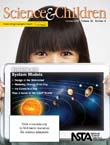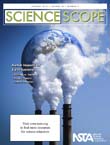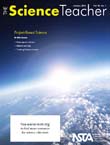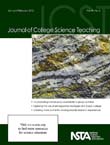NSTA’s K–College Science Education Journals: January 2015 Issues Online
By Lauren Jonas, NSTA Assistant Executive Director
Posted on 2015-01-07
 Is your science classroom equipped for success? Or are you teaching with limited resources? Either way, the K–College journals from the National Science Teachers Association (NSTA) have the answers you need. Written by science teachers for science teachers, these peer-reviewed journals are targeted to your teaching level and are packed with lesson plans, expert advice, and ideas for using whatever time/space you have available. Browse the January issues; they are online (see below), in members’ mailboxes, and ready to inspire teachers!
Is your science classroom equipped for success? Or are you teaching with limited resources? Either way, the K–College journals from the National Science Teachers Association (NSTA) have the answers you need. Written by science teachers for science teachers, these peer-reviewed journals are targeted to your teaching level and are packed with lesson plans, expert advice, and ideas for using whatever time/space you have available. Browse the January issues; they are online (see below), in members’ mailboxes, and ready to inspire teachers!
 Science and Children
Science and Children
An interaction of two or more things can be considered a system, and the resulting system can help us understand phenomena. This issue explores systems and the models used to understand them.
Featured articles (please note, only those marked “free” are available to nonmembers without a fee):
- Design in the Watershed
- Free – Editor’s Note: Systems and System Models
- EQuIP-ped for Success
- In the Watery World
- Modeling Change With Clay
- Printing the Playground
- Free – Virtual Modeling
- Full Table of Contents
 Science Scope
Science Scope
Many of us have probably witnessed our footprints in the sand being washed away by the incoming tide. Unfortunately, the cumulative weight of our species footprint on our planet grows each day and is not so easily erased. To explore the ever-threatening human impact on Earth systems, check out the articles in this issue.
Featured articles (please note, only those marked “free” are available to nonmembers without a fee):
- Aliens Invade and Drop Off Litter
- Free – Editor’s Roundtable: Branching Out on the Family Tree
- Free – EQuiP-ped for Success: A Rubric to Help Implement the Next Generation Science Standards
- Life With Limited Resources: Using Aquatic Plants to Study Resource Consumption
- No Space? Little Money? No Garden? Not So Fast!
- Plotting Plants: Tracking Invasive Species in the Local Community
- The Human Impact on Earthquakes: Natural Fracturing Versus Fracking
- Full Table of Contents
 The Science Teacher
The Science Teacher
Project-based learning can be an important instructional model for meeting the three-dimensional learning goals of the Next Generation Science Standards. Complex, real-world projects provide opportunities for students to deeply engage in multiple science and engineering practices—like developing and using models, constructing explanations, and engaging in argument from evidence—while learning specific disciplinary core ideas and crosscutting concepts that can be used to make sense of phenomena and design solutions to relevant problems. This issue offers a variety of examples that may inspire you to try project-based science in your own classroom.
Featured articles (please note, only those marked “free” are available to nonmembers without a fee):
- Free – Editor’s Corner: Project-Based Science Learning
- EQuIP-ped for Success
- Global Warning
- Near-Space Science
- Free – Project-Based Science
- The Community Connection
- Treating Pompe Disease
- Full Table of Contents
 Journal of College Science Teaching
Journal of College Science Teaching
Can online homework assignments predict the development of problem-solving skills for students taking an introductory physics course? See “The Role of Online Homework” to find out. Read about an innovative student-centered program with a focus on research designed to increase STEM retention rates of underrepresented students. Also, don’t miss the study that examines the teaching beliefs and practices of science faculty with education specialties and how these beliefs and practices relate to national pedagogical reform efforts.
Featured articles (please note, only those marked “free” are available to nonmembers without a fee):
- Case Study: Grandma’s TUM-my Trouble: A Case Study in Renal Physiology and Acid-Base Balance
- Changing College Majors: Does It Happen More in STEM and Do Grades Matter?
- Developing University and Community Partnerships: A Critical Piece of Successful Service Learning
- Incorporating More Individual Accountability in Group Activities in General Chemistry
- It Takes a Village to Make a Scientist: Reflections of a Faculty Learning Community
- Planning and Implementing a Comprehensive Student-Centered Research Program for First-Year STEM Undergraduates
- Research and Teaching: A New “Class” of Undergraduate Professors: Examining Teaching Beliefs and Practices of Science Faculty With Education Specialties
- Research and Teaching: Effects of a Science Content Course on Elementary Preservice Teachers’ Self-Efficacy of Teaching Science
- Research and Teaching: Implementing Comprehensive Reform of Introductory Physics at a Primarily Undergraduate Institution: A Longitudinal Case Study
- Free – The Role of Online Homework in Low-Enrollment College Introductory Physics Courses
- Two-Year Community: Learning How Students Learn: An Exploration of Self-Regulation Strategies in a Two-Year College General Chemistry Class
- Full Table of Contents
Get these journals in your mailbox as well as your inbox—become an NSTA member!
The mission of NSTA is to promote excellence and innovation in science teaching and learning for all.
Follow NSTA
| |
|
|
|
Disclaimer: The views expressed in this blog post are those of the author(s) and do not necessarily reflect the official position of the National Science Teaching Association (NSTA).


